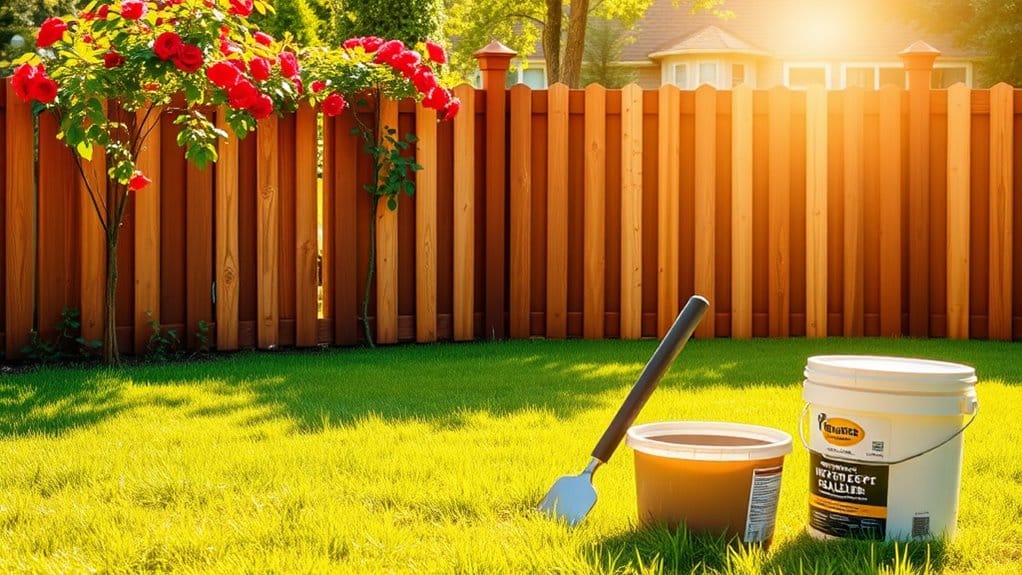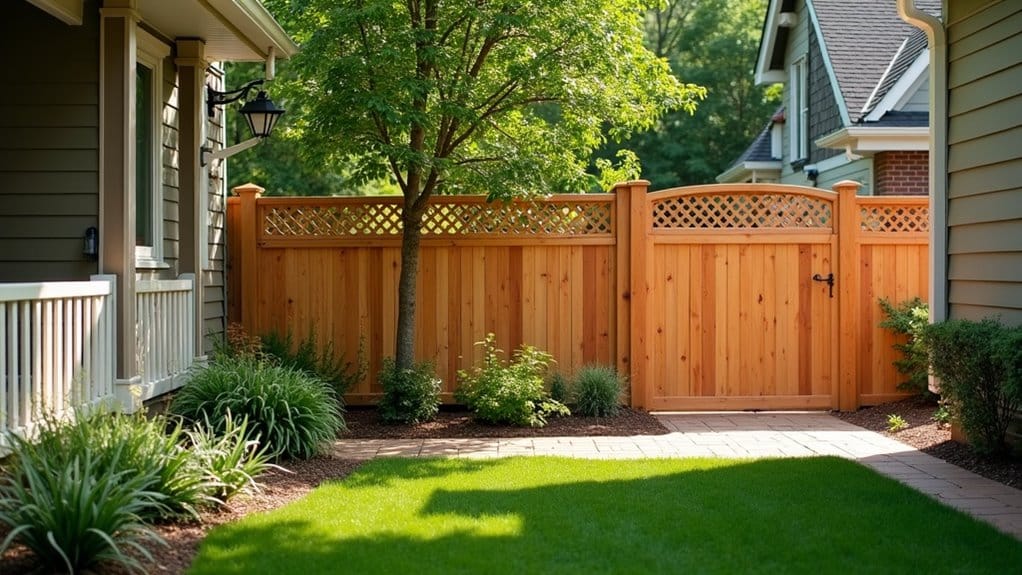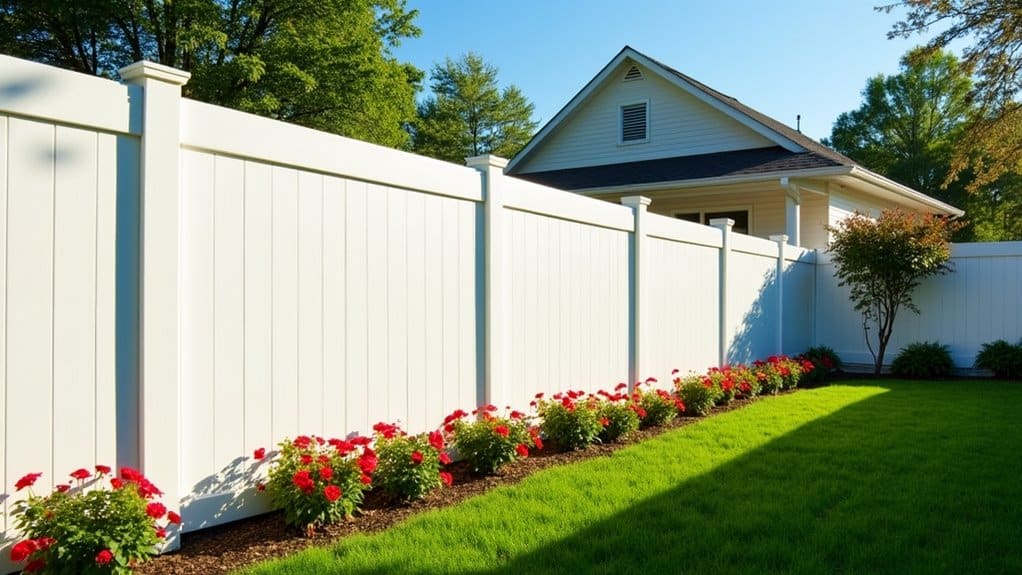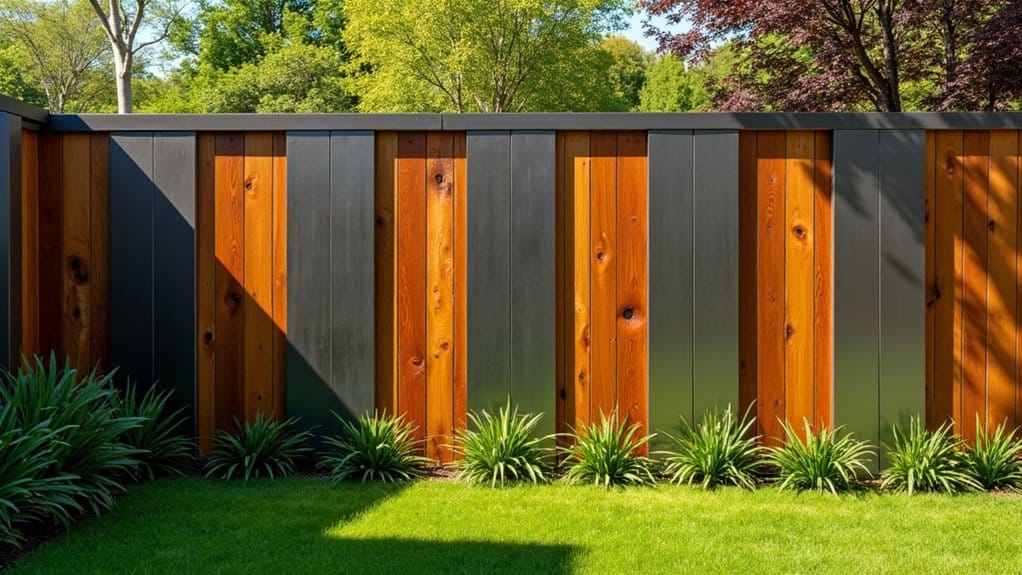To keep your residential fence looking great and lasting longer, start with regular cleaning and inspections. Clean wooden fences annually and other materials every 1-2 years to prevent mold and dirt buildup. After cleaning, apply a sealer—oil-based for durability or water-based for faster drying. Regularly check for damage; reinforce loose boards and replace any rotting posts immediately. Choose a design that enhances your home's style and landscape. Seasonal maintenance will help your fence stay beautiful throughout the year. By following these tips, you can ensure your fence remains appealing and functional.
Key Takeaways
- Clean and inspect your fence regularly to catch damage early and prolong its life, especially with seasonal checks.
- Apply sealers every 1-3 years after cleaning to protect wooden fences from moisture and weather-related wear.
- Fix any issues quickly by replacing damaged parts and tightening loose boards to keep your fence sturdy.
- Opt for eco-friendly cleaning products and sustainable materials to benefit both your fence and the environment.
- Choose a fence style that complements your home's architecture to boost curb appeal and create a cohesive look in your yard.
Importance of Regular Cleaning
Regular cleaning of your residential fence is crucial for its upkeep. Dirt, stains, and mold or mildew, especially in shaded or humid areas, are signs that it's time to clean.
Wooden fences should be cleaned annually to prevent rot, while vinyl and metal fences can be cleaned every 1-2 years. However, don't overlook mold in shaded areas. A well-maintained fence contributes to overall home aesthetics, enhancing your property's visual appeal. Regular inspections help you spot issues early, so you can fix them before they worsen. Additionally, proper material choice can significantly influence the longevity of your fence, making regular cleaning even more important.
Factors like humidity, foot traffic, and nearby plants can cause dirt to build up faster, making more frequent cleaning necessary.
Sealing and Protection Methods
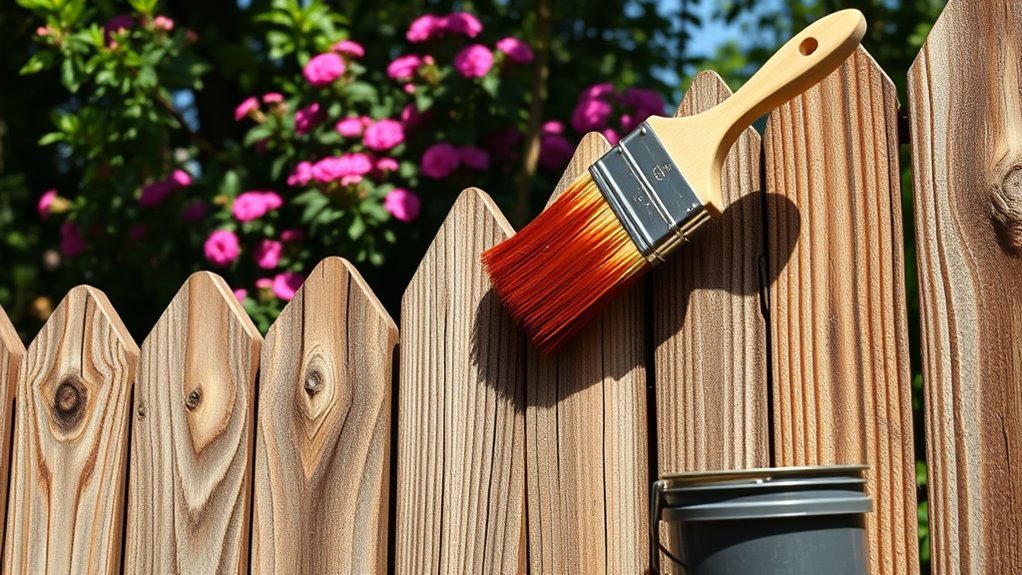
To maintain your fence's integrity, the next step after cleaning is to apply the right sealers. Choose from oil-based or water-based options. Oil-based sealers offer strong protection for wood, especially in sunny, dry climates, but take about 24 hours to dry. Water-based sealers dry quicker—within four hours—making them better for humid areas, though they may need more coats. If you're looking for an eco-friendly choice, natural sealers can enhance the wood's appearance while offering protection.
Before applying the sealer, ensure your fence is clean and dry. You can use a brush, roller, or sprayer for even coverage, starting from the top and moving down. It's important to note that sealing your fence enhances the durability of wooden fences, providing a protective layer against moisture. Additionally, regular sealing is crucial, as proper maintenance can extend the lifespan of your fence significantly.
Pay special attention to end grains and joints, applying additional coats as needed, based on the manufacturer's guidelines. Reapply sealers every 1-3 years to keep your fence in top condition. By choosing the right sealer and applying it properly, you can enhance your fence's appearance and extend its lifespan.
Conducting Inspections
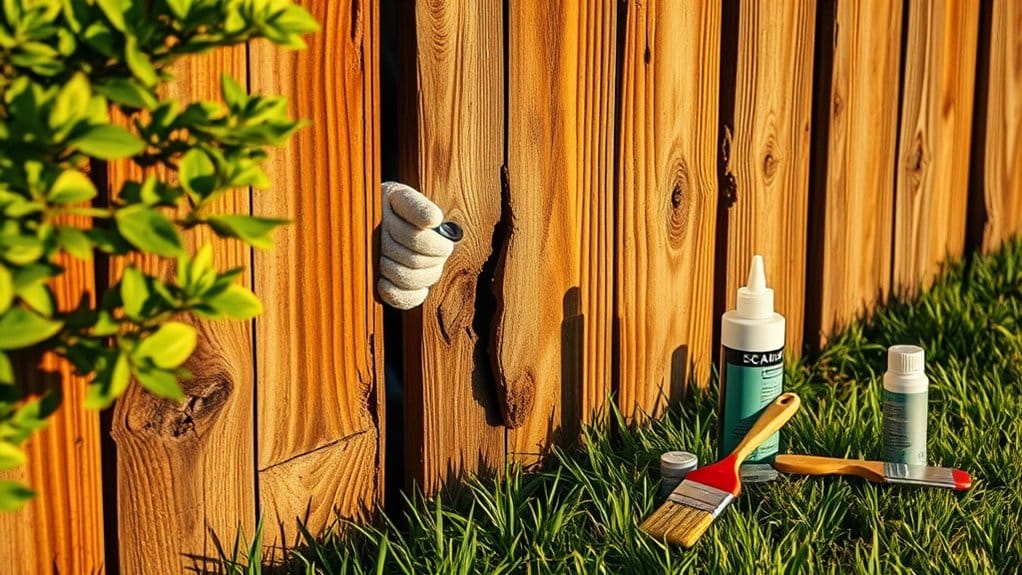
To keep your fence in great shape, regular inspections are key. Here's a simple guide to checking your fence:
- Visual Check: Look for damage like wood rot or rust along the entire fence.
- Post Stability: Shake each post gently. If it wobbles, it needs reinforcement.
- Panel Condition: Press on wooden panels for soft spots and check metal fencing for bends or breaks.
- Hardware Check: Inspect all hardware for looseness or rust. Missing pieces can weaken the fence.
Use a tape measure to check height, a level to ensure it's straight, and a moisture meter for wooden fences. Regular inspections can also help improve your fence's overall durability by identifying issues before they escalate. Additionally, keeping an eye on local ordinances can ensure your fence remains compliant with regulations.
Keep an inspection checklist handy to make the process easier. By staying on top of these inspections, you'll extend your fence's lifespan and ensure it continues to protect your property effectively.
Addressing Repairs Promptly
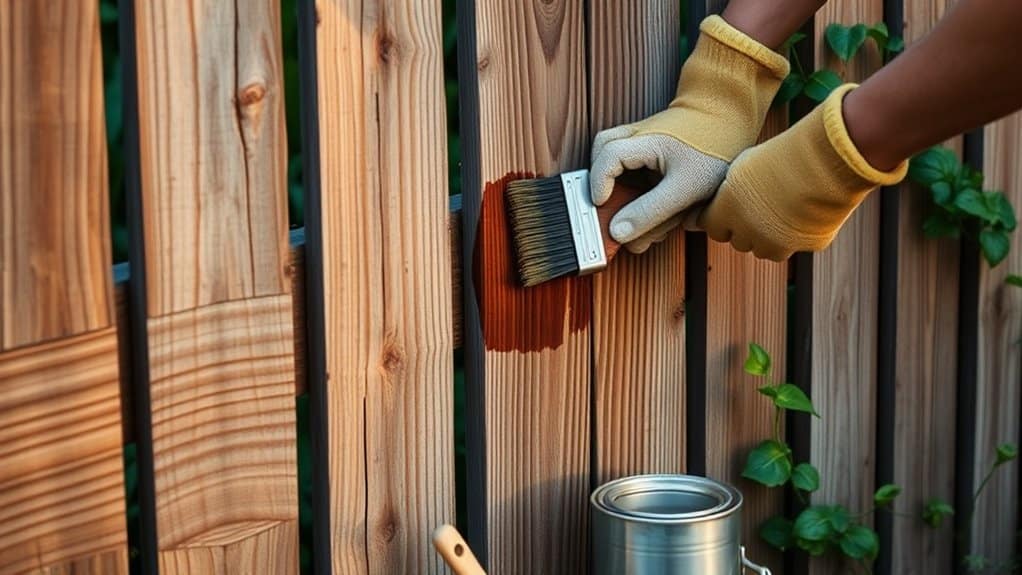
Addressing repairs quickly is crucial for keeping your residential fence in good shape. When you spot damage, act fast to evaluate how serious it is.
For rotted wooden posts, replacing them with concrete or metal reinforcements will ensure they stay strong. If you have loose boards, secure them immediately with screws or nails to avoid bigger problems later. Additionally, if you notice a leaning gate, it's important to check the hinges and the posts to prevent further issues. Regular maintenance can significantly extend the life of your fence and reduce repair costs.
Adding wooden blocks to reinforce fence panels during repairs can also help. Make sure you have the right tools on hand, like a saw, drill, and screws, to make repairs easier.
Different materials require specific repair methods. For example, chain-link fences need linesman's pliers, while vinyl ones can be fixed with a screwdriver.
If the damage is too complicated, it's wise to call a professional. This not only protects your warranty but also ensures safety.
Acting quickly not only protects your fence but also keeps it looking great.
Environmental Considerations
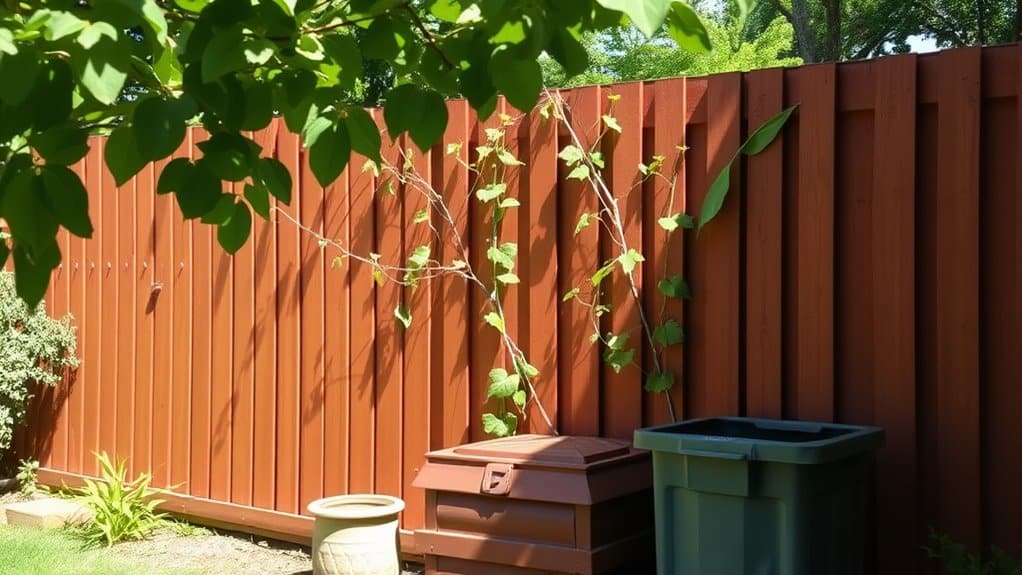
Repairing your fence with environmental impact in mind not only extends its life but also supports sustainable practices. Here are four essential tips to consider:
- Choose Sustainable Wood: Select wood from responsibly managed forests, like those certified by the Forest Stewardship Council (FSC). This promotes biodiversity and protects ecosystems. Additionally, consider using vinyl fencing as a sustainable alternative that minimizes the need for ongoing resource consumption.
- Clean Eco-Consciously: Use mild soap or biodegradable cleaners with soft brushes for maintenance. Avoid harsh chemicals that can damage the environment. Regular eco-friendly maintenance can significantly reduce waste and landfill contributions.
- Go for Natural Protection: Use water-based stains and sealants made from natural ingredients. They shield your fence from moisture and UV rays without releasing harmful chemicals. Vinyl fencing, on the other hand, requires no painting or staining, further reducing the environmental impact.
- Reduce Waste: Regular maintenance not only lengthens your fence's life but also cuts down on the need for repairs or replacements, keeping waste out of landfills.
Taking these steps ensures your fence is both durable and environmentally friendly.
Seasonal Maintenance Practices
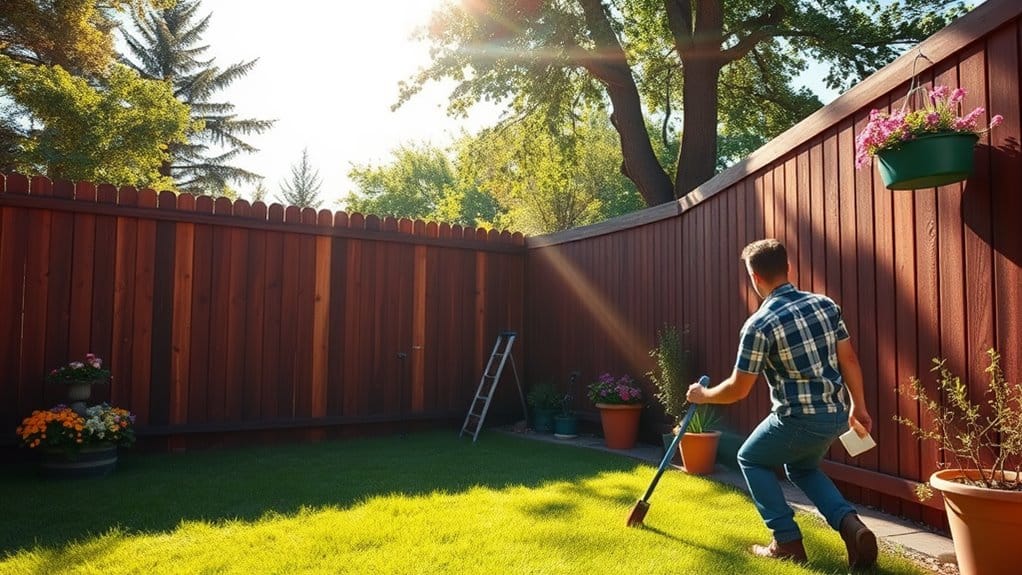
To keep your fence in great condition, adjust how often you inspect it based on the seasons. Different climates affect fences in unique ways, so customizing your maintenance routine helps your fence handle the elements. For instance, during the spring, it's crucial to perform a thorough cleaning and inspect for damage to ensure your fence is ready for the upcoming seasons.
Seasonal Inspection Frequency
Inspect your residential fence four times a year to ensure its durability and appearance.
Here's a simple checklist for each season:
- Spring: Look for rot in posts, loose boards, and rust on hardware. Clean with a power washer and apply sealant for UV protection.
- Summer: Check for warping in wooden boards and signs of insect infestations. Ensure proper drainage and inspect gate hinges for stability. Regularly applying protective coatings can help prevent moisture damage.
- Fall: Clear debris to prevent moisture buildup. Inspect for damage and tighten loose screws or nails. Address minor issues promptly.
- Winter: Remove snow to avoid weight damage. Check for wood decay and rust on metal. Make sure fasteners are secure and consider protective treatments against harsh weather.
Regular inspections help you catch problems early and keep your fence looking great.
Climate-Specific Care Adjustments
To keep your fence in good shape throughout the year, adjust your care routine for each season.
Spring: Clean your fence with a garden hose or pressure washer. Look for damage and apply a protective finish to guard against moisture and UV rays. Trim any nearby plants that might trap moisture against the wood. Regularly scheduled regular cleaning is essential for maintaining the appearance and integrity of your fence.
Summer: Check for warping or splitting as temperatures rise. Use a UV-resistant sealant to protect against the sun. Regularly clean to prevent dirt buildup and keep plants trimmed for better airflow. Inspect and repair any damage early to avoid more extensive repairs later on.
Fall: Remove leaves and debris to prevent moisture damage. Tighten any loose boards and apply a water repellent in preparation for winter. Trimming vegetation during this time also helps prevent moisture buildup against the fence.
Winter: Watch for snow and ice accumulation and gently remove it with a broom. After storms, inspect for moisture damage, and steer clear of de-icing salts near metal fences to avoid corrosion. Ensure proper drainage around the fence to prevent standing water, which can cause significant damage.
Consistent Upkeep Strategies
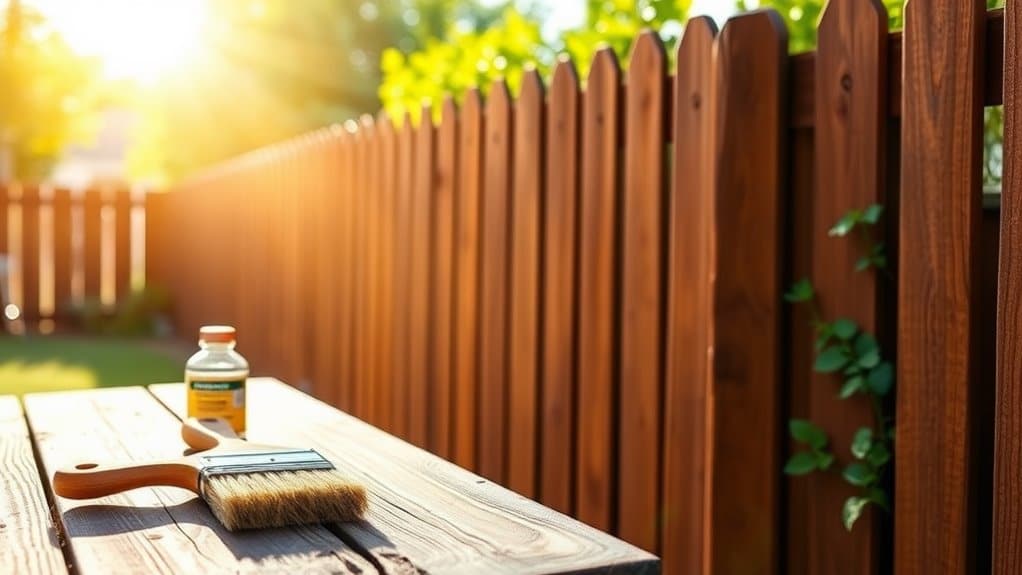
To keep your fence in top shape, regularly clean it and inspect it for damage. Make it a habit to remove dirt and debris, and look for any issues that might weaken it. Additionally, regular inspections can help identify signs of rot or damage early, ensuring your fence remains sturdy and visually appealing.
Regular Cleaning Practices
To keep your residential fence looking great, establish a regular cleaning routine. This not only improves its appearance but also extends its lifespan.
Here are some simple practices to follow:
- Frequency: Pressure wash your fence at least once a year to get rid of dirt and grime.
- Detergent Types: Use mild detergents for wooden fences and specialized solutions for vinyl.
- Cleaning Technique: Clean from the bottom up and left to right to avoid streaks. Work in sections to ensure all detergent is removed.
- Rinsing Method: Rinse thoroughly using low-to-medium pressure, following the same bottom-up and left-to-right method for an even clean. Regular pressure washing not only enhances your fence's appeal but also helps to remove mold and mildew that can cause damage over time.
Scheduled Inspections Routine
Regular inspections are crucial for keeping your residential fence in good condition. Start by checking the post hole depth to ensure it meets local building codes.
Next, confirm that the fence is properly placed according to your permit and property lines.
During each inspection, examine the posts, panels, and gates for any signs of damage, rot, or instability. Catching these issues early can prevent costly repairs later on.
Seasonal checks are especially useful for addressing any weather-related wear and tear.
Make sure your fence complies with local regulations, as this not only enhances safety but also protects your property's value.
Conducting mid-installation and final inspections can help identify potential problems early, saving you time and money.
Enhancing Aesthetic Appeal
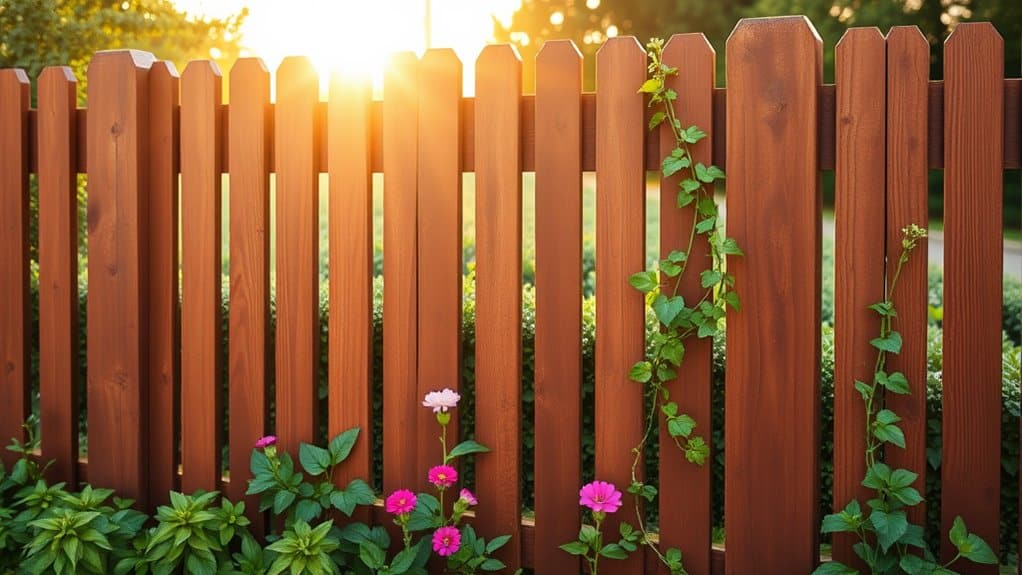
Fences are more than just boundaries; they enhance your property's aesthetic appeal. To create visual harmony, choose fence styles that match your home's architecture and colors.
Here are four tips to integrate your fence with your landscape effectively:
- Select the Right Style: For traditional homes, classic wood fences work well, while modern designs suit contemporary settings. Picket fences add a charming touch.
- Outline Outdoor Spaces: Use fences to define areas like gardens or pathways, giving your landscape structure.
- Keep It Maintained: Regularly clean your fence and address any repairs. Wooden fences should be treated with waterproof stain, while metal fences need rust checks.
- Define Areas: Use tall privacy fences to enclose serene gardens, and low picket fences to enhance flower beds' charm.
Adapting to Material Needs
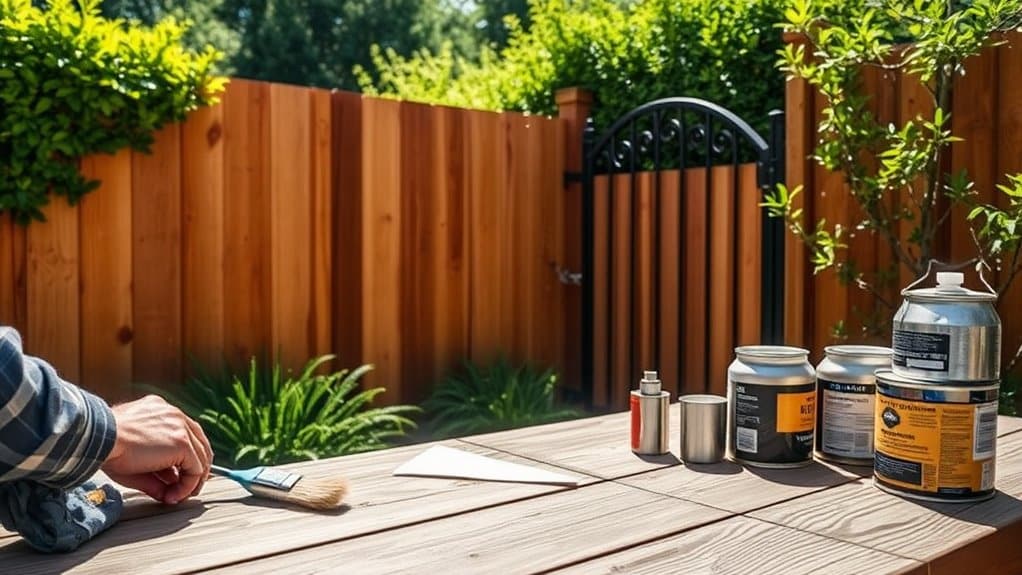
Choosing the right material for your fence is crucial for meeting your needs and handling the weather. When picking materials, think about wood treatments that match your choice. For example, cedar and redwood need less care because they resist decay naturally, while pine requires more frequent treatments.
Here's a quick guide:
| Material | Treatment Needs | Durability |
|---|---|---|
| Cedar | Seal every 1-2 years | High |
| Redwood | Seal every 1-2 years | High |
| Pine | Treat every 6-12 months | Moderate |
Keep your fence clean on both sides to avoid debris and check for pests regularly. Adjust your maintenance based on the seasons, especially focusing on wood treatment during wet months. Replace any damaged sections quickly to keep your fence strong. Remember, the material you choose affects the fence's lifespan and look, so stay proactive about its care.
Frequently Asked Questions
How Often Should I Clean My Fence?
Clean your fence once a year or twice a year, based on the material and the environment. For example, wood fences may need more frequent cleaning if they're in a damp area. Use soft brushes and mild soap for effective cleaning to keep your fence looking good and lasting longer.
What Type of Sealant Is Best for My Fence?
Not all sealants are created equal. For your fence, oil-based sealants soak in deeper for long-lasting protection, while water-based options dry faster and are easier to clean up. Choose the right one based on your needs, and follow proper application techniques for the best results.
Can I Paint My Fence After Sealing?
Yes, you can paint your fence after sealing it. Just make sure to clean and sand the surface first. Use good quality paints, like latex or oil-based, for a durable finish that lasts on the sealed surface.
How Do I Prevent Pests From Damaging My Fence?
To keep pests from damaging your fence, use pest repellents regularly and treat the fence as needed. Check for weak spots, remove debris, and keep plants at a distance. This makes your fence less inviting for unwanted critters.
What Should I Do if My Fence Is Leaning?
If your fence is leaning, start by figuring out why. You can reinforce it with concrete for extra support or replace any damaged posts. Regular inspections can help prevent future problems and keep your fence sturdy and straight.
Conclusion
To keep your residential fence in top shape, regular maintenance is key. A well-maintained fence boosts your home's curb appeal, giving your yard a welcoming feel. Simple tasks like cleaning, sealing, and inspecting your fence can significantly extend its life and enhance its look. Stay on top of seasonal maintenance and make repairs as soon as you notice issues. This way, your fence will remain a sturdy and attractive boundary for years to come.

